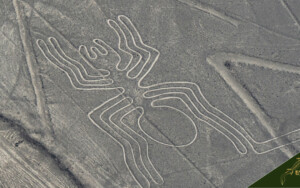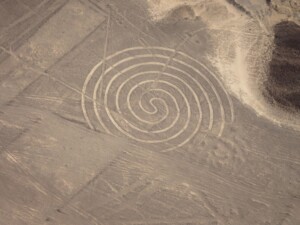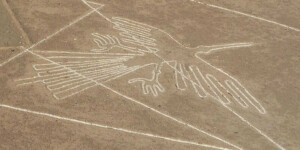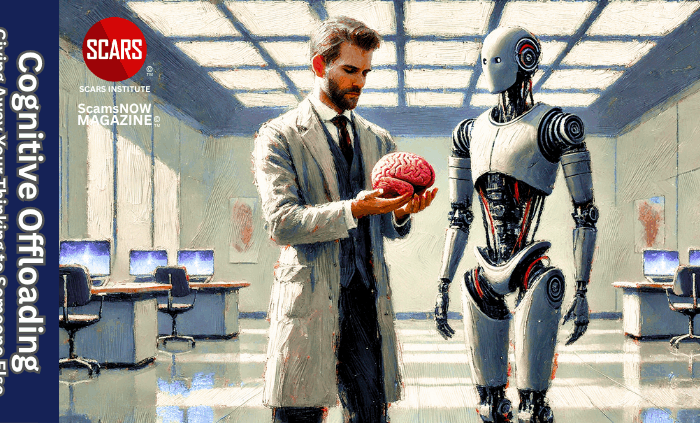Labyrinth Walking and Spiral Walking Meditation for Scam Victims
A Much Easier Form of Meditation for Scam Victims on their Journey of Recovery
Scam Victim Recovery Psychology
Authors:
• Vianey Gonzalez B.Sc(Psych) – Licensed Psychologist Specialty in Crime Victim Trauma Therapy, Neuropsychologist, Certified Deception Professional, Psychology Advisory Panel & Director of the Society of Citizens Against Relationship Scams Inc.
• Tim McGuinness, Ph.D. – Anthropologist, Scientist, Director of the Society of Citizens Against Relationship Scams Inc.
About This Article
Labyrinth walking and spiral walking provide scam victims with accessible and profound methods for managing trauma, reducing stress and anxiety, and promoting recovery. Unlike complex forms of meditation, these practices offer a tangible and straightforward approach to mindfulness.
Labyrinths, with their single winding path leading to the center and back, offer a focused journey inward, while spirals provide a continuous inward journey with no dead ends. Both can be created physically or imagined, allowing flexibility in practice.
By setting intentions and walking mindfully, individuals can find stress relief, clarity, emotional healing, and connection with others. Integrating labyrinth or spiral walking into mindfulness routines enhances its benefits, offering opportunities for reflection, gratitude, and sharing.
These practices offer scam victims a sacred space for inner peace, resilience, and transformation on their journey toward healing and recovery.
Note: This article is intended for informational purposes and does not replace professional medical advice. If you are experiencing distress, please consult a qualified mental health professional.

A Note About Labeling!
We often use the term ‘scam victim’ in our articles, but this is a convenience to help those searching for information in search engines like Google. It is just a convenience and has no deeper meaning. If you have come through such an experience, YOU are a Survivor! It was not your fault. You are not alone! Axios!
Finding Peace: Labyrinth Walking and Spiral Walking Meditation for Scam Victims to Manage Trauma, Reduce Stress and Anxiety, and Promote Recovery
After a scam, navigating through the maze of emotions and thoughts can feel overwhelming but meditation can help to bring mindfulness, especially approaches such as Labyrinth Walking or Spiral Walking.
While therapy and support groups offer valuable tools for healing, there’s another practice that scam victims might find beneficial: walking meditation – an ancient form of meditation that is less challenging for most people. This ancient form of walking meditation provides a path to inner peace and clarity, offering solace and support on the journey toward recovery. The secret is in following a path either labyrinth walking in a slightly complex pattern, or spiral walking in a spiraling circle toward a center and then reversing out.
What is Labyrinth Walking?
A labyrinth is a winding path, often laid out in a circular or complex design, that leads walkers on a journey toward the center and then back out again. Unlike a maze, which has multiple paths and dead ends, a labyrinth has only one path, making it impossible to get lost. This simplicity allows walkers to focus inward, free from the distractions of decision-making.
Labyrinths have been used for thousands of years by various cultures and religions as tools for meditation, prayer, and reflection. They can be found in churches, parks, and other public spaces, offering a sanctuary for seekers of all backgrounds.
Some claim that the Nazca Lines in Peru were used for this purpose, to take the walker on a mindful, spiritual, or religious journey to a destination in their mind.
How to Walk a Labyrinth:
If you don’t have access to a physical labyrinth, don’t worry! You can create a temporary one using simple materials like chalk, rope, or even sticks. You can also imagine one in your mind and follow the path as if it was real.
Here’s how to do it:
- Find a quiet space: Choose a quiet, peaceful location where you won’t be disturbed during your walk. This could be indoors or outdoors, depending on your preference and the availability of space. Though, it is better if it is outdoors and with plenty of space. Backyards or parks are great, but make sure it is relatively quiet and you will not be disturbed.
- Mark out the path: Use chalk, rope, or other materials to mark out a winding path on the ground. You can create a simple circular design or get creative with different patterns and shapes. If this is impractical, you can imagine the path in your mind.
- Set your intention: Before you begin walking, take a moment to set an intention for your practice. This could be a word, phrase, or prayer that represents what you hope to gain from the experience. You can use the Four SCARS Affirmations: I am a Survivor; It was not My Fault; I am NOT Alone; Axios; or something else.
- Start walking: Begin at the entrance of the labyrinth and slowly walk along the path toward the center. Take your time and allow yourself to move at your own pace, focusing on each step as you go. For some counting steps is a way to help stay focused on the purpose.
- Reach the center: Once you reach the center of the labyrinth or the design, pause for a moment of reflection. This is a sacred space where you are connecting with your inner self. Tell yourself some profound truth that maybe you need to hear.
- Return outward: After spending time in the center, continue walking along the path as it leads you back out of the labyrinth. Again, take your time and stay present with each step. If you are counting steps, reverse the countdown now back to one.
- Reflect on your experience: When you reach the end of the labyrinth, sit down calmly, breathe deeply, and take a few moments to reflect on your experience. Notice any thoughts, feelings, or insights that arose during your walk.
What is Spiral Walking?
Spiral walking is a form of meditative movement, just like labyrinth walking, in which individuals walk a spiral path, either in a natural setting or created using simple materials like stones or chalk. Unlike a labyrinth, which has only one path leading to the center and back out again, a spiral offers a continuous journey inward, with no dead ends or turns. You can begin clockwise or anti-clockwise (consider starting in the direction of your dominant hand.)
The spiral has been used for centuries as a symbol of growth, transformation, and evolution. By walking a spiral path, individuals can tap into this symbolism and embark on a journey of self-discovery and healing.
How to do Spiral Walking:
Walking a spiral is a simple yet profound practice that can be done alone or with others.
Here’s how to get started:
- Find a quiet space: Choose a quiet, peaceful location where you won’t be disturbed during your walk. This could be indoors or outdoors, depending on your preference and the availability of space. Though, it is better if it is outdoors and with plenty of space. Backyards or parks are great, but make sure it is relatively quiet and you will not be disturbed.
- Create the spiral: Use stones, chalk, or other materials to create a spiral path on the ground or you can do it completely in your mind. A spiral is easier to picture in your mind. Start outside the spiral and walk, spiraling inward, to the center and then pause, and walk back out again. You can make the spiral as large or as small as you like, depending on the space available.
- Set your intention: Before you begin walking, take a moment to set an intention for your practice. This could be a word, phrase, or prayer that represents what you hope to gain from the experience. You can use the Four SCARS Affirmations: I am a Survivor; It was not My Fault; I am NOT Alone; Axios; or something else.
- Start walking: Begin at the outer edge of the spiral and slowly walk toward the center. Take your time and allow yourself to move at your own pace, focusing on each step as you go. For some counting steps is a way to help stay focused on the purpose.
- Reach the center: Once you reach the center of the spiral, pause for a moment of reflection or prayer. This is a sacred space where you can connect with your inner self. Tell yourself some profound truth that maybe you need to hear.
- Return outward: After spending time in the center, continue walking along the spiral path as it leads you back out. Again, take your time and stay present with each step. If you are counting steps, reverse the countdown now back to one.
- Reflect on your experience: When you reach the end of the labyrinth, sit down calmly, breathe deeply, and take a few moments to reflect on your experience. Notice any thoughts, feelings, or insights that arose during your walk.
Benefits of Labyrinth Walking or Spiral Walking
Labyrinth walking or spiral walking offers a variety of benefits for scam victims and anyone seeking healing and inner peace:
- Stress reduction: The rhythmic movement of walking combined with the meditative nature of the labyrinth can help reduce stress and anxiety. As you focus on each step, you can release tension and find a sense of calm. Plus the actual act of moving releases tension and promotes circulation. Some prefer to do it barefoot so there is more tactile connection. It can be done barefoot on grass or even snow, but if a rough surface, you should probably use some foot covering.
- Clarity and insight: Labyrinth walking or spiral walking provides a space for quiet reflection and introspection, allowing you to gain clarity and insight into your thoughts and emotions. You may discover new perspectives or solutions to challenges as you move through the labyrinth. For some, meditation while sitting may actually be harder since you have nothing to focus on.
- Emotional healing: Scam victims often experience a range of intense emotions, from anger and betrayal to sadness and shame if they really allow themselves to feel while walking. Labyrinth or spiral walking offers a safe and supportive environment for processing these feelings and finding healing.
- Connection with others: While labyrinth walking or spiral walking is typically done alone, it can also be a shared experience. Walking with others can create a sense of community and connection, providing unspoken support and encouragement along the journey.
- Mindfulness practice: Pattern walking is a form of mindfulness meditation, which involves paying attention to the present moment, each footstep with openness and curiosity. By focusing on each step and breath, you can cultivate mindfulness and presence in your daily life. You can also try to time your breathing with your steps.
- Spiritual exploration: Pattern walking can be a sacred journey of connection with your beliefs. It offers an opportunity for prayer, contemplation, and communion with something greater than oneself.
Integrating Labyrinth Walking or Spiral Walking into Mindfulness Practices
Labyrinth walking or spiral walking, in other words, pattern walking, can complement and enhance other mindfulness practices, such as meditation, yoga, and journaling.
Here are some tips for integrating this into your mindfulness routine:
- Set aside time: Schedule regular sessions for labyrinth walking, just as you would for other mindfulness activities. Find a time and place that works for you and commit to making it a priority.
- Combine with meditation: Begin or end your labyrinth walk with a short meditation or breathing exercise to center yourself and prepare for the experience. This can help deepen your connection to the practice and enhance its benefits.
- Reflect and journal: After each labyrinth walk, take time to reflect on your experience and write down any insights or observations in a journal. This can help you integrate the lessons learned into your daily life and track your progress over time.
- Consider the journey: You can compare the journey of labyrinth or spiral walking with the crime if you want, the journey in and your recovery journey out. Every time you make the journey in it becomes faster, and every time you walk out more healing and releasing.
- Practice gratitude: As you walk the labyrinth, cultivate a sense of gratitude for the opportunity to engage in this sacred practice and for the support and resources available to you on your healing journey. When you make it out and sit down, think about what you are grateful for.
- Share with others: Consider inviting friends, family members, or fellow scam victims to join you for a labyrinth walk. Sharing the experience with others, such as in the support group, can deepen your connection and provide mutual support and encouragement.
Summary
Labyrinth walking and spiral walking are powerful tools for healing and self-discovery, offering scam victims a path to inner peace and resilience.
By incorporating this ancient practice into their mindfulness routine, scam victims can reduce stress, gain clarity, and find healing on their journey toward recovery. Whether walking alone or with others, the walked path offers a sacred space for reflection, connection, and transformation.
Please Rate This Article
Please Leave Us Your Comment
Also, tell us of any topics we might have missed.
Leave a Reply
Thank you for your comment. You may receive an email to follow up. We never share your data with marketers.
-/ 30 /-
What do you think about this?
Please share your thoughts in a comment above!
More Mindfulness Related Information:
- Anxiety And Mindfulness – A Tool For Scam Victims – 2024 – [VIDEOS] (scamsnow.com)
- Mindfulness Breathing For Scam Victims Recovery 2024 (scamsnow.com)
- Scam Victims In The RAIN – A Mindfulness Approach For Recovery – 2024 (scamsnow.com)
- SCARS BLUE BOOK – Scam Victim’s Recovery Journal – SCARS Company Store (againstscams.org)
- Trauma & Nutritional Health – Take Your Vitamins – 2023 (scamsnow.com)
- Scam Victim Stress – The Psychological, Cerebral, and Physiological Effects – 2024 (scamsnow.com)
- Coping with Scam Victim Trauma: Exploring Positive and Negative Coping Mechanisms – 2024 (scamsnow.com)
- The Amygdala Hijack And Scam Victims [Infographic] – Expanded 2024 (romancescamsnow.com)
- Multitasking Creates Scam Victim Vulnerabilities – 2024 (scamsnow.com)
- The Tao – The Philosophy of the Path to Recovery (scamsnow.com)
- Understanding Grief & Complex Grief for Scam Victims 2024 (scamsnow.com)
-/ 30 /-
What do you think about this?
Please share your thoughts in a comment above!
SCARS LINKS: AgainstScams.org RomanceScamsNOW.com ContraEstafas.org ScammerPhotos.com Anyscam.com ScamsNOW.com
reporting.AgainstScams.org support.AgainstScams.org membership.AgainstScams.org donate.AgainstScams.org shop.AgainstScams.org
youtube.AgainstScams.org linkedin.AgainstScams.org facebook.AgainstScams.org
ARTICLE RATING
TABLE OF CONTENTS
CATEGORIES
MOST POPULAR COMMENTED ARTICLES
POPULAR ARTICLES
U.S. & Canada Suicide Lifeline 988
![NavyLogo@4x-81[1]](https://scamsnow.com/wp-content/uploads/2025/04/NavyLogo@4x-811.png)
ARTICLE META
WHAT PEOPLE ARE TALKING ABOUT LATEST SITE COMMENTS
See Comments for this Article at the Bottom of the Page
on Samurai Wisdom and Rituals for Clearing the Mind After Scam Trauma – 2025 – [VIDEOS]: “A great guide on how to move forward in our recovery process with a calm mind, cleansed on an ongoing…” Jun 28, 07:34
on Delayed Gratification and Patience in Scam Victim Recovery – 2025 – [VIDEOS]: “We want to recover quickly and… we make new mistakes. How not to speed up the recovery process, how to…” Jun 28, 06:41
on The Unique Injury Of Betrayal Trauma On Scam Victims – 2024: “Primarily because you did not see it coming” Jun 27, 23:57
on Changes In A Scam Victim’s Life: “I really detest the way my trust in others has been affected by the scamming I went through. I used…” Jun 27, 14:47
on The Unique Injury Of Betrayal Trauma On Scam Victims – 2024: “Betrayal Trauma is the worst feeling ever. Why does it seem so much worse when a scammer does that to…” Jun 27, 14:34
on EMDR Therapy For Scam Victims’ Trauma – A Part Of The Recovery Process For Many – 2024: “Very comprehensive article explaining all aspects of EMDR. I’d only heard of it before and now I have a much…” Jun 26, 19:01
on Forgiving Yourself After Surviving a Romance or Investment Scam – 2025: “Thank you for this valuable article. Self-forgiveness was for me the biggest step that led to my recovery. That also…” Jun 26, 17:28
on Counseling And Your Native Language: “These points make perfect sense. I can’t imagine trying to express complex emotions in a second language. I realize many…” Jun 26, 16:05
on Thought-Terminating Cliches – How What You and Others Say Stops Critical Thinking and Recovery for Scam Victims – 2025: “I didn’t realize that these “innocent phrases” clichés ending thoughts, can have such effect / negative -inhibiting / on our…” Jun 26, 14:48
on Scam Victim Resistance In Support Groups Therapy Or Counseling Can Destroy Opportunities For Recovery – 2024: “Working with either a support group or therapist to me means a self commitment to actively participating in the therapy.…” Jun 24, 21:01
on ‘I Just Want To Forget It’ – Denial & Avoidance Are Natural But Will Not Help Scam Victims On Their Path To Recovery From Scams – 2024: “My financial loss, the shock and betrayal of the crime ending all combined to fray my nerves and spend hours…” Jun 24, 20:10
on You Hate Being Told What To Do? How Your Rebellious Mentality Can Sabotage Your Recovery – 2025: “I am a bit of a rebel, and the moment someone tells me to do something, worse, does it even…” Jun 24, 15:04
on You Hate Being Told What To Do? How Your Rebellious Mentality Can Sabotage Your Recovery – 2025: “You are very welcome” Jun 24, 03:01
on You Hate Being Told What To Do? How Your Rebellious Mentality Can Sabotage Your Recovery – 2025: “This is a great article, which makes perfect sense as to why anyone would resist the help offered to them.…” Jun 23, 20:01
on Scam Victims’ Responsibilities – 2021 [Updated 2025]: “Thank you for this article. As I continue my journey, I focus on the here and now and let the…” Jun 21, 16:26
on Scam Victims Avoid Or Escape The Aftermath Of Scams – How Denial And Distraction Avoid Confronting Reality – 2024: “In the earliest days after my crime I felt powerless, helpless and weak. I had been through so much in…” Jun 21, 14:46
on Problems and Opportunities – Thoughts on Psychological Reframing – 2025: “An article that really helped me look at the problems in my life from a different point of view and…” Jun 21, 14:42
on Scam Victims Avoid Or Escape The Aftermath Of Scams – How Denial And Distraction Avoid Confronting Reality – 2024: “Thank you for another great article! This discussion of avoidance and other tactics some can use to deny the existence…” Jun 17, 12:20
on Helping Scam Victims Understand The Social Isolation Risks After A Relationship Scam – 2024: “This article very informatively shows the risk of social isolation especially after a scam. Although I can acknowledge the list…” Jun 17, 11:31
Important Information for New Scam Victims
Please visit www.ScamVictimsSupport.org – a SCARS Website for New Scam Victims & Sextortion Victims
SCARS Institute now offers a free recovery program at www.SCARSeducation.org
Please visit www.ScamPsychology.org – to more fully understand the psychological concepts involved in scams and scam victim recovery
If you are looking for local trauma counselors, please visit counseling.AgainstScams.org
If you need to speak with someone now, you can dial 988 or find phone numbers for crisis hotlines all around the world here: www.opencounseling.com/suicide-hotlines
Statement About Victim Blaming
Some of our articles discuss various aspects of victims. This is both about better understanding victims (the science of victimology) and their behaviors and psychology. This helps us to educate victims/survivors about why these crimes happened and not to blame themselves, better develop recovery programs, and help victims avoid scams in the future. At times, this may sound like blaming the victim, but it does not blame scam victims; we are simply explaining the hows and whys of the experience victims have.
These articles, about the Psychology of Scams or Victim Psychology – meaning that all humans have psychological or cognitive characteristics in common that can either be exploited or work against us – help us all to understand the unique challenges victims face before, during, and after scams, fraud, or cybercrimes. These sometimes talk about some of the vulnerabilities the scammers exploit. Victims rarely have control of them or are even aware of them, until something like a scam happens, and then they can learn how their mind works and how to overcome these mechanisms.
Articles like these help victims and others understand these processes and how to help prevent them from being exploited again or to help them recover more easily by understanding their post-scam behaviors. Learn more about the Psychology of Scams at www.ScamPsychology.org
SCARS INSTITUTE RESOURCES:
If You Have Been Victimized By A Scam Or Cybercrime
♦ If you are a victim of scams, go to www.ScamVictimsSupport.org for real knowledge and help
♦ Enroll in SCARS Scam Survivor’s School now at www.SCARSeducation.org
♦ To report criminals, visit https://reporting.AgainstScams.org – we will NEVER give your data to money recovery companies like some do!
♦ Follow us and find our podcasts, webinars, and helpful videos on YouTube: https://www.youtube.com/@RomancescamsNowcom
♦ Learn about the Psychology of Scams at www.ScamPsychology.org
♦ Dig deeper into the reality of scams, fraud, and cybercrime at www.ScamsNOW.com and www.RomanceScamsNOW.com
♦ Scam Survivor’s Stories: www.ScamSurvivorStories.org
♦ For Scam Victim Advocates visit www.ScamVictimsAdvocates.org
♦ See more scammer photos on www.ScammerPhotos.com
You can also find the SCARS Institute on Facebook, Instagram, X, LinkedIn, and TruthSocial
Psychology Disclaimer:
All articles about psychology and the human brain on this website are for information & education only
The information provided in this and other SCARS articles are intended for educational and self-help purposes only and should not be construed as a substitute for professional therapy or counseling.
Note about Mindfulness: Mindfulness practices have the potential to create psychological distress for some individuals. Please consult a mental health professional or experienced meditation instructor for guidance should you encounter difficulties.
While any self-help techniques outlined herein may be beneficial for scam victims seeking to recover from their experience and move towards recovery, it is important to consult with a qualified mental health professional before initiating any course of action. Each individual’s experience and needs are unique, and what works for one person may not be suitable for another.
Additionally, any approach may not be appropriate for individuals with certain pre-existing mental health conditions or trauma histories. It is advisable to seek guidance from a licensed therapist or counselor who can provide personalized support, guidance, and treatment tailored to your specific needs.
If you are experiencing significant distress or emotional difficulties related to a scam or other traumatic event, please consult your doctor or mental health provider for appropriate care and support.
Also read our SCARS Institute Statement about Professional Care for Scam Victims – click here
If you are in crisis, feeling desperate, or in despair, please call 988 or your local crisis hotline.
More ScamsNOW.com Articles
A Question of Trust
At the SCARS Institute, we invite you to do your own research on the topics we speak about and publish. Our team investigates the subject being discussed, especially when it comes to understanding the scam victims-survivors’ experience. You can do Google searches, but in many cases, you will have to wade through scientific papers and studies. However, remember that biases and perspectives matter and influence the outcome. Regardless, we encourage you to explore these topics as thoroughly as you can for your own awareness.



















![scars-institute[1]](https://scamsnow.com/wp-content/uploads/2025/04/scars-institute1.png)
![niprc1.png1_-150×1501-1[1]](https://scamsnow.com/wp-content/uploads/2025/04/niprc1.png1_-150x1501-11.webp)

I Googled Labyrinth walking path near me and found a number of them in my community, I visited an few and finally settled on one that I enjoyed walking in. I asked the owner permission to walk there and have started my meditative walking. I really enjoyed it and have found peace and calmness to my day.
I also find similar benefits of Labyrinth walking with my daily run. I usually reflect on my recovery progress with SCARS and current situations with my personal & professional life.